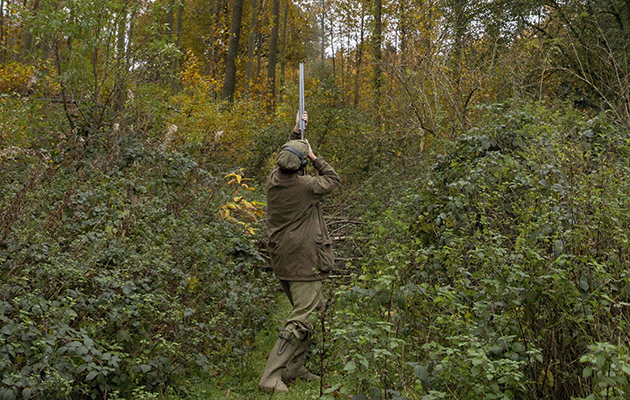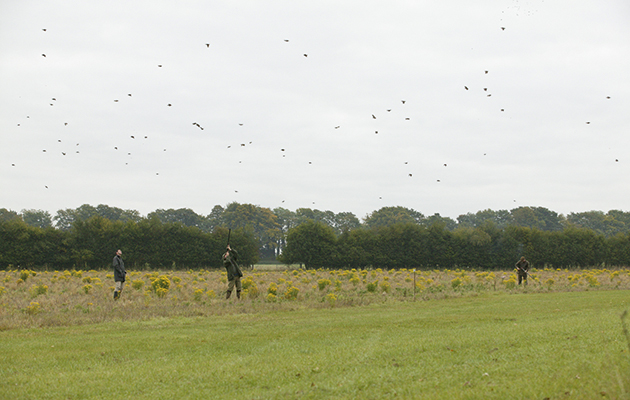Mike Yardley gives a masterclass in mastering forward allowance
Different types of birds need addressing differently and your forward allowance should vary accordingly. What is forward allowance? It is allowing for the forward movement of a bird – in simple terms, it means that if you want to hit a moving bird you must shoot where it is going rather than where it was.
Forward allowance is one of the hardest shooting techniques to master but here is a guide to improving your skill.
Perfecting your forward allowance shooting technique
Possibly the greatest skill in using a shotgun is applying forward allowance – “leading” your bird to make due allowance for its velocity in flight.
There are so many opinions given by “experts” trying to sell their way of shooting that forward allowance gets to be quite confusing. Most ballistic pundits suggest that one should “swing through” from behind in one way or another or that one must “maintain” a lead. Some advocate pointing at the bird and pushing or pulling ahead. Others (Robert Churchill and Major Ruffer) state that it is an error to think about forward allowance consciously at all. One should only watch the bird and leave the rest to a practised mount and natural hand-to- eye coordination. Lord Walsingham, one of the greatest of wing-shots, offered little advice on forward allowance but did say, “hold high and don’t check”, ie, hold high and don’t stop your swing prematurely (if you do, you will almost certainly miss behind).
Forward allowance in different situations
Learning to shoot competently has a great deal to do with learning about forward allowance in different situations.
For British driven-shooting, for example, most seem to fare best in my opinion (and that of most British shooting instructors) with one or other variation on the swing through. It has not evolved as the dominant game-shooting method without good reason. Maintained or sustained lead as mentioned – staying in front of the bird throughout the swing – also has its uses, especially for high birds and wildfowling, and is popular with clay-shots.
Pulling away is simple (and may be a useful default when the wheels fall off). Spot-shooting instinctively – shooting at a point in front of the mark without much or any lateral movement – may occasionally buy time at closer ranges when engaging live or artificial quarry. It is the way a significant number of self-taught guns shoot. Maintained lead also potentially buys time, but I think its main use in the field is for longer shots. At closer ranges it may result in over-leading, and it can be a poor technique for those with eye-dominance issues.
There is much subtle variation to be considered with forward allowance. Factors such as gun speed and acceleration must be taken into account (as well as flight speed and angle) in any sophisticated exploration of forward allowance. Some techniques advocate constant gun movement, others don’t. We all see lead in different ways. Some see it in inches (those who look at the muzzles, generally an error); some see it in feet; some may not look for a specific distance, instead, they are only aware of a gap the width of which may change depending on circumstance. Some claim not to see lead at all.
9 techniques for forward allowance
CLASSIC SWING THROUGH – where one comes in on the bird’s flight line from some distance behind and fires as one passes through the bird or a moment later.
GRADUATED SWING THROUGH – I have developed this for shooting high birds. (Read more on shooting high birds here.) At the beginning of the shot, one determines to start behind the bird about as far as one intends to go in front of it. On an average driven shot one might start about 1yd to the rear to come roughly as much in front of the bird. On a high shot one might start 2yd or 3yd behind (or even more in exceptional circumstances) to come as much in front. This technique of forward allowance is a little more precise, a little less wild than conventional swing through and it is a particular aid to establishing line, which is critically important on high birds.
CLOSE SWING THROUGH – an observed variation of classic swing through where the shooter mounts on to the bird’s tail feathers or just behind and pushes through in front in the normal way.
PULL AWAY – one moves the muzzles of the gun on to the bird initially, tracks it briefly and pulls or pushes away (a method of forward allowance better suited to early clay instruction than game-shooting).
POINT AND PUSH – this is a method I use for teaching basic game- and clay-shooting. One points at the bird momentarily and moves on smoothly without any tracking phase.
CLASSIC MAINTAINED LEAD – here one applies a precise measured lead without letting the muzzles fall behind the bird at any time. It is especially popular among American wildfowlers and for skeet-shooting.
MOVE, MOUNT, SHOOT – here one can maintain a lead in front of the target by means of natural hand-to-eye coordination without deliberate measuring. John Bidwell is famous for developing this. The movement to the bird may also be different than with conventional maintained lead – one may come up diagonally to meet the bird’s line (when clay-shooting his hold point for the muzzles is halfway back and halfway down from the line of flight).
SNAP-SHOOTING – where you shoot at a spot in front of the bird. An instinctive method used by a significant number of self-taught game-shots, it cuts gun movement to a minimum with certain inevitable risks.
AMBUSHING – this involves intercepting a target typically with a stationary gun (not generally recommended).
(Read: improve your game and clay shooting)
The best method
They all work, they all have their uses; some are more generally applicable than others.
Swing through
For game-shooting at normal ranges, I usually advise a swing-through technique of some sort first. Swing through has the advantage of establishing line well and, crucially, it ensures that you shoot with an accelerating gun. The danger of swing-through shooting is that it can encourage a wild swing beginning too far behind the bird (hence the graduated swing through variation).
So, swing through is good for establishing line and it keeps the barrels moving well. In my experience it works best at normal ranges when the “point of insertion” of the muzzles is not too far behind the bird. Maintained lead ensures, usually, that one remains in front of a moving mark but it does not establish reference with the bird and it may encourage a hesitant swing or stopping mid-swing (especially when one measures too deliberately). Instinctive maintained lead in the manner of John Bidwell is fast, like spot-shooting, but there is more gun movement and therefore it may be more consistently applied. With all maintained-lead techniques, most misses tend to be in front, and they can be a poor choice for those with eye-dominance issues who shoot with both eyes open.
Point and push
Point and push is simple to understand and is another method that ensures one shoots with an accelerating gun. It is based on natural pointing ability – one starts by merely pointing the gun at the bird and then pushes forward. I would say its best application is at mid-range and less. It is a good way to start someone off before methods that may require more gun control are considered. It is not as good for establishing line or encouraging fluent movement as swing through.
Conscious or unconscious forward allowance?
Some – for example, Robert Churchill, Major Ruffer and John Bidwell – note that it is a mistake to look deliberately for lead on any occasion. Few today suggest that we should take a tape measure to each bird, although old books are full of diagrams which give, to my mind, over-precise instructions in various situations. I advise practising different techniques as a means to understand forward allowance better and to develop control of your gun. It is not just a question of thinking about lead or seeing it, one must learn to feel it.
I believe, nevertheless, that some may usefully be told to “get a yard more in front of that” or “give it a couple of feet more and a little higher on line”. The latter comment makes the point that lead is not just a question of forward allowance but may require contemplation or correction of elevation (I have heard the term duplex lead used to refer to such situations). Some don’t react well to such precise instruction but some do. The knowledge that the average pheasant requires about 51⁄2ft of lead at 30yd, 8ft at 40yd, and 11ft at 50yd is useful.
Many experienced shots do not routinely need to look for a deliberate picture inside 30yd or so but may need to be a little more precise beyond that, ie, outside their comfort zone. Once they have understood the requirement of consistently shooting in front of a moving bird and have taken on board the need to shoot in front of a moving target, the correct lead will often be applied automatically provided they are shooting with good timing, good balance and, crucially, sustained visual contact.
Putting method aside, one simply cannot over-state the importance of sustaining focus. In the shooting context, vision itself is most definitely a skill and one closely related to the effective application of forward allowance.
Line as well as lead
Never forget that line is often as important as lead. One must remain conscious of it and adjust accordingly.
Finally, my experience as a shooting instructor is that, regardless of specific technique, most people have an inadequate range of leads in their imaginary library. They attempt to shoot all birds in more or less the same way. For them, instruction is often about extending their “lead library”. It usually comes as a revelation that some birds need no lead at all, while others need the proverbial five-bar gate.
This article was originally published in 2016 and has been updated.










